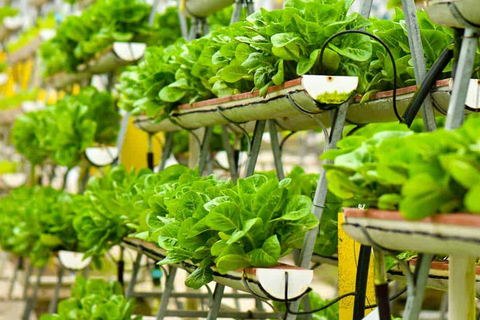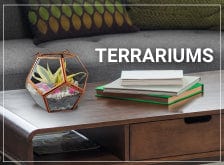How to Grow
Step by Step Guide to setup the Vertical Garden
Vertical gardening is trending among urban dwellers who wish to create a lush garden in their tall rise homes. There are many advantages to having a vertical garden including creating a green cover that purifies the air and also attracts birds and butterflies. Vertical gardening is also popular among many who want to create a kitchen garden and grow their own fruits and vegetables.

Steps to Setup the Vertical Garden
Here we discuss how you can easily set up a vertical home for your plants and shrubs by following just 10 easy steps.
Step 1: Select a Wall
You can choose a wall in your home that you want to cover up or beautify. This can be a balcony wall or one that receives enough sunlight. Make sure that the wall you select has all the suitable conditions required for proper plant growth. You can purchase specific plants that grow well in your selected spot.

Step 2: Create the Frame
The wall setup of your vertical garden is usually a three-layer sandwich of the frame, plastic sheeting, and fabric. Experts suggest using a PVC pipe to build the basic structure of the frame. Plastic is considered to be a better option compared to metal or wood frames as they are susceptible to changes in the external environment and may rot when exposed to moisture. You can build the frame on the wall itself or you can create a frame that can be hanged on the wall. Many gardeners prefer the latter as this way they can easily remove and re-fix the frame as and when the need arises.

Step 3: Attach a Plastic Sheet
After you create the frame, you must attach a plastic sheet over it. This is a very important step as the plastic will act as a barrier between the fabric (the third layer) and the wall. As the fabric will have high moisture content, the plastic sheet will prevent water from creating fungus or mold on the wall.

Step 4: Attach Two Layers of Fabric
The final layer you need to attach is the fabric that will hold the water required for your plants to grow. Experts suggest using felt carpet padding or other fabric materials that can retain water well and not rot easily.
You must use two layers of fabric to ensure durability and to create a pouch for your plants. The fabric must be stretched and then stapled onto the frame with stainless steel staples or galvanized screws. The fabric should not have any wrinkles or folds and must be stretched well till it is taut.

Step 5: Add the Irrigation System
The irrigation system will provide the water necessary for your plants to grow. You can create a system using poly tubing and fittings that lock. The tube can be placed across the top of the frame and the water will drip through the emitters on the tube. If you are having trouble setting up the system, you can get a system from TrustBasket. Once the frame is set you can attach it to the wall using rust-proof hardware.

Step 6: Add Fertilizer and Connect Irrigation System to Water Source
Fertilization is extremely important. You can attach a liquid fertilizer injector to the valve of the irrigation system. You can also use a water filter to keep the water free of dust and other particles that might create a block in the system. The irrigation system must then be connected to the water source. Water dripping to the ground is inevitable so you can place a few plant pots underneath your vertical garden setup. With a self-watering irrigation system, you can easily maintain your green wall and ensure it receives enough water even when you are away from home.

Step 7: Attach the Pots or Pouches
There are specific pots that are available for vertical gardening setups. You can attach the pots one above the other in a vertical format until you have created the desired height for your green wall. There are different types and sizes of colorful plant pots available in the online plant store so you can easily choose a set of planters or pots that are right for your vertical garden. You can add PVC pipes along the length of the frame and hang the readily available vertical garden pots to the frame with ease.

Step 8: Choose Your Plants
Before choosing the plants you need to consider the humidity, wind, sun, and the shade your vertical garden will be receiving. Selecting native plants that thrive in your weather condition will help to keep your garden green throughout the seasons. Some of the common plants preferred for vertical gardens in India are crotons, ferns, bromeliads, pothos, dracaena, and succulents. You can also grow fruits and vegetables like cucumbers, melons, peas or tomatoes, on the vertical garden. If you are creating a detachable green wall, then you can easily remove it during extreme summers and protect your plants by placing the frame in shade.

Step 9: Place the Plants
Instead of buying vertical planters, you can directly place the plants on the fabric layer itself by making a horizontal cut in the outer layer of the fabric and inserting the plant in the cut. You can create a pouch-like holding for the plant by attaching the fabric to the plastic layer using stainless steel staples. Soon, the plants will take over the frame and you will be left with a beautiful wall garden.

Step 10: Maintenance
Vertical gardens are a boon for people with mobility issues as they can easily take care of the green wall without having to bend down to prune or water the plants. The space-saving installation makes it easy for anyone tending their garden to remove shedding foliage, manage any pest, refill fertilizer, test irrigation system, trim plants or refurbish the wall with seasonal plants.

Conclusion
To create a beautiful vertical garden place plants that grew 2 to 3 feet in height in the pots/slots arranged in the top part. You can place ferns and succulents in the slots below as this will provide the necessary shade for the plants to grow. A vertical garden is also a great conversation starter among friends and family and can be a peaceful spot at home. If you want to quickly fix a green wall at home, you can choose vertical garden pots and pouches from TrustBasket.com. We offer a wide range of plastic garden pots that are ideal for vertical gardens. You can explore our range and build a beautiful wall garden in no time. To know more about the colorful outdoor plant pots we offer, visit https://www.trustbasket.com/collections/best-vertical-gardening-pots-in-india
Popular Searches: Garden Accessories for Sale, Compost Bin India, Plastic Flower Pots Online, Contemporary Plant Pots, Hanging Pots Online, Colourful Plant Pots, Bird Feeders Online, Rectangular Planters Online, Small Pots Online, Flower Pots Online, Kitchen Waste Compost Bin, Balcony Railing Planter




am so happy to learn from this cannel and share and implement more of what i have learn
am so happy to learn from this cannel and share and implement more of what i have learn
am so happy to learn from this cannel and share and implement more of what i have learn
So beautiful
So beautiful